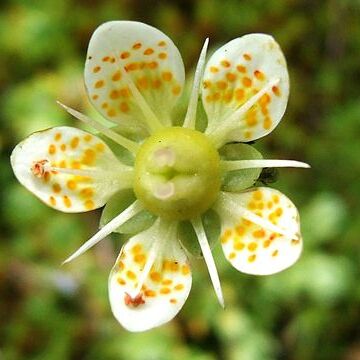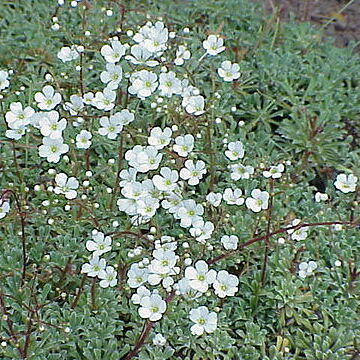Herbs, perennial, rarely biennial (Saxifraga) or annual (Cascadia, Saxifraga), rhizomatous or not, stoloniferous or not, persistent stem ± erect as caudex, horizontal as rhizome, or intergrading, branched or unbranched, sometimes bearing bulbils (Bolandra, Lithophragma, Micranthes, Saxifraga, Suksdorfia). Flowering stems appearing in spring, summer, or autumn with leaves usually present (usually appearing in autumn or winter after basal leaves have withered in Jepsonia), leafless, or leafy and bearing 1-5 cauline leaves proximally, glabrous or short to long stipitate-glandular or eglandular, hairs usually multicellular (unicellular in Astilbe, Saxifragopsis). Leaves usually in basal rosettes, sometimes cauline, usually alternate, sometimes opposite (Chrysosplenium, Lithophragma, Mitella, Saxifraga), usually simple (compound in Astilbe, sometimes compound in Lithophragma, Tiarella); stipules absent or present; petiole absent or present, usually not jointed distally at attachment to blade (jointed distally in Saxifragopsis), usually not peltate (peltate in Darmera), not producing adventitious buds at apices of petioles of basal rosette and cauline leaves (usually producing adventitious buds at apices of petioles in Tolmiea); blade margins entire, crenate, serrate, or dentate, ciliate or glandular-ciliate. Inflorescences usually terminal racemes, panicles, cymes (simple or compound), thyrses (with lateral dichasial or monochasial cymose branches), or solitary flowers (Chrysosplenium, Lithophragma), sometimes axillary cymes (Chrysosplenium), usually arising from terminal or axillary buds in rosettes, 2-300(-1000+)-flowered, bracteate or ebracteate. Flowers usually bisexual, sometimes unisexual (Astilbe, Saxifraga), homostylous (heterostylous in Jepsonia), usually radially symmetric, sometimes bilaterally symmetric (Bensoniella, Heuchera, Micranthes, [Saxifraga], Tiarella, Tolmiea); perianth and androecium hypogynous, perigynous, or epigynous; hypanthium free (Bolandra, Jepsonia) or ± adnate to ovary, usually not split to base (split to base in Tolmiea); sepals usually (4-)5(-6), distinct; petals usually (4-)5(-6) or absent, distinct, lobed or unlobed; nectary disc often encircling ovary distally at junction of ovary and free portion of hypanthium; stamens (2-)5(-9)10; anthers usually dehiscent longitudinally, rarely by broad terminal openings (Leptarrhena); staminodes absent; pistils 1, sometimes appearing 2-3+ (Micranthes), usually 2-carpellate, rarely 3-carpellate (Astilbe, Lithophragma, Micranthes), carpels connate for full length of ovary to barely connate proximally, equal, rarely unequal (Tiarella); ovary superior to inferior, 1-2(-3)-locular, ovaries fully connate when 1-locular, proximally connate to varying degrees when 2-and 3-locular (Astilbe, Micranthes); placentation axile, appearing marginal when ovaries are barely connate, or parietal; ovules anatropous, usually bitegmic, rarely unitegmic (most Micranthes), crassinucellate; styles 2-3(-4), distinct or connate (Saxifragopsis); stigmas 2-3(-4), capitate. Fruits capsular, sometimes folliclelike (Cascadia, Micranthes), 2-3(-4)-beaked, equally valvate (unequally valvate in Tiarella), dehiscence septicidal between beaks. Seeds 5-200, tan, brown, dark brown, black, yellowish brown, reddish brown, or red, rarely winged (Astilbe, Jepsonia, Sullivantia), ellipsoid, fusiform, ovoid, oblong, spheroid, oblong-cylindric, flat, or straight on 1 side, convex on other, rarely prismatic, smooth, wrinkled, ribbed, papillate, pitted, or ridged, tuberculate, warty, spiny, cellular-rugulose, or muricate; embryo straight; endosperm oily, copious.
More
Herbs or shrubs, rarely trees or vines. Leaves simple or compound, usually alternate or opposite, usually exstipulate. Flowers usually in cymes, panicles, or racemes, rarely solitary, usually bisexual, rarely unisexual, hypogynous or ± epigynous, rarely perigynous, usually biperianthial, rarely monochlamydeous, actinomorphic, rarely zygomorphic, 4-or 5(-10)-merous. Sepals sometimes petal-like. Petals usually free, sometimes absent. Stamens (4 or)5-10 or many; filaments free; anthers 2-loculed; staminodes often present. Carpels 2, rarely 3-5(-10), usually ± connate; ovary superior or semi-inferior to inferior, 2-or 3-5(-10)-loculed with axile placentation, or 1-loculed with parietal placentation, rarely with apical placentation; ovules usually many, 2-to many seriate, crassinucellate or tenuinucellate, sometimes with transitional forms; integument 1-or 2-seriate; styles free or ± connate. Fruit a capsule or berry, rarely a follicle or drupe. Seeds albuminous, rarely not so; albumen of cellular type, rarely of nuclear type; embryo small.
Perennial herbs, rarely short-lived or annual, usually rhizomatous or stoloniferous. Leaves usually alternate, all basal or with a few cauline leaves, simple or sometimes compound (not in Australia), entire or variously toothed, often sheathing the stem; stipules present or absent. Inflorescence usually a terminal raceme or cyme, sometimes flowers solitary. Flowers actinomorphic or zygomorphic, bisexual or unisexual, perigynous or epigynous, hypanthum free or adnate to ovary. Sepals (3–) 5 (–10). Petals (4–) 5 (–6), inconspicuous or well developed, entire or lobed, sometimes absent. Stamens usually 5 (not in Australia) or 10; anthers basifixed, dehiscing longitudinally or by terminal opening. Gynoecium of 2, rarely 3 carpels, sometimes only fused basally. Ovary inferior to superior, usually 2-locular; ovules numerous; styles free or united basally; stigmas usually capitate. Fruit a dehiscent or indehiscent capsule, sometimes follicle-like; seeds few to numerous.
Ovary 1–5-celled, free or adnate to the receptacle; styles usually free; ovules numerous, on axile or parietal placentas or the latter pendulous from the apex of the cells
Stamens inserted with the petals, 5–10; filaments free; anthers 2-celled, dehiscing longitudinally
Petals alternate with the sepals or absent, often clawed, perigynous or rarely epigynous
Seeds usually numerous, small, with endosperm; embryo minute, straight
Leaves usually alternate (opposite in Vahlia), exstipulate
Flowers actinomorphic, hermaphrodite, rarely solitary
Sepals usually 5, imbricate or valvate
Herbs, not or slightly succulent


